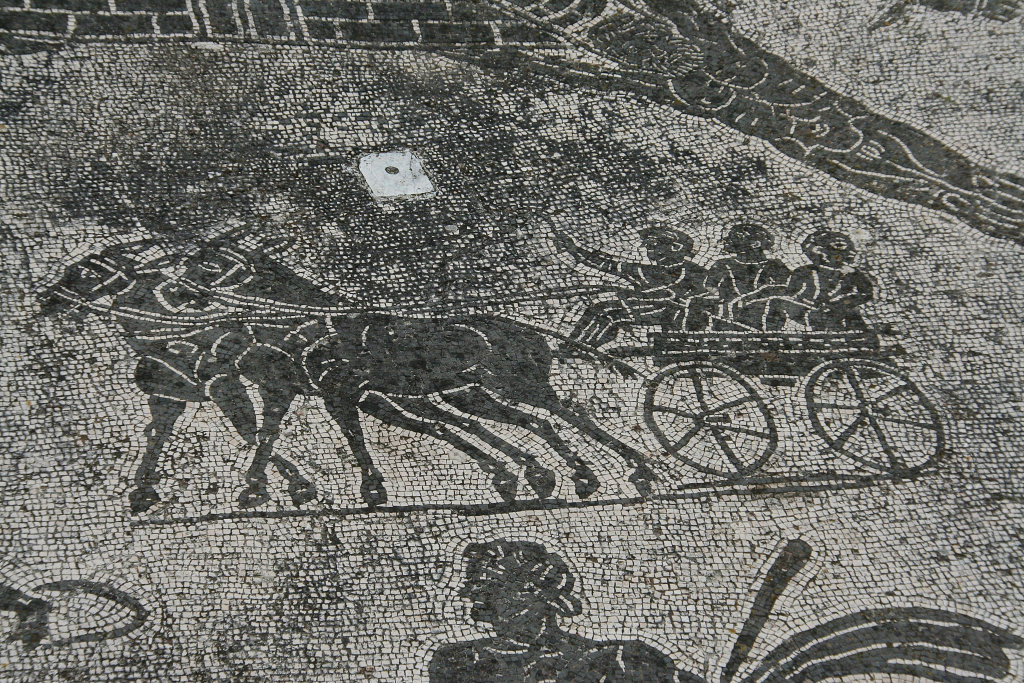|
The Baths of the Coachmen were built during the early reign of Hadrian and modified extensively in the second half of the third century. The coaches are depicted on a large mosaic. They may be compared to cabs, used for passenger transport to and from Rome - not everybody had a horse at his disposal. The cabs were stationed outside the baths, near the Roman Gate. A long basin on the other side of the street may well have contained the drinking water for the animals that pulled the wagons. It has been suggested that the guild of the coachmen owned the baths, but that is speculation. Taking a bath here would be tempting, after a long trip on the dusty Via Ostiensis. In frigidarium C is the mosaic that gave the building its name. It is best viewed from the modern asphalt road. The border consists of a city wall (referring to Rome?). In the centre is a further city wall with gates and towers (referring to Ostia?). Towers at the four angles are supported by "telamones": figures of Atlas, "male caryatids". Around this wall we see the small, two-wheeled coaches or carriages, called in Latin cisia, driven by cisiarii, coachmen. They were drawn by mules, and the names of some of these are inscribed: Pude(n)s ("Modest"), Podagrosus ("Arthritic"), Potiscus ("Thirsty"?), Barosus ("Silly"). Around the wagons are some marine figures. To the east of the frigidarium is room D, containing a black-and-white mosaic with geometric motifs. To the south-west is heated room B, with in the west part an apse that was added in the third century. A black-and-white mosaic in this room is also an addition from the third century. Depicted are a Nereid on a sea-monster, and in the apse a naked, winged amorino on a sea-cow. In room F (c. 13 x 8 m.) stands a large, stone basin on a foot. In this room many fragments were found of stucco reliefs that once decorated the ceiling. Depicted are gorgoneia, sea monsters, Nereids, Mercurius, and erotes (late second century AD). To the east are rooms A and E. Room A was heated, and contains a Hadrianic mosaic of wild animals hunting. Room E contains the remains of a mosaic depicting athletes, with a mutilated Greek inscription. At the south end, in room G, the wooden remains of a waterwheel were found in the 1990's. Groundwater was lifted by slaves walking inside the wheel. The water may have been taken to a reservoir above a room to the north of the wheel. To the east of the wheel is a rectangular basin. The building contains two bars. In the west part of the building is bar H, in the east part bar J. The bar counter in the south-east part of the latter room has disappeared almost completely. Room H contains remains of a bar counter in the north-west corner, a large buried storage jar (dolium defossum) in the south-west corner, and next to this a masonry structure that was lined with marble. In one of the walls is a small niche for a statuette of a deity.
In the building two mediaeval lime-kilns were found, with several statues that for some reason were not burned. |
 Plan of the baths. After SO I. |













 Stucco relief from room F: a Nereid on a sea-bull and a Gorgoneion. Photo: Mielsch 1975, Taf. 87,1. Drawing: Parco Archeologico di Ostia. |
 |
 |
 |
| Stucco relief from room F: a sword between columns, Mercurius with caduceus and purse. Photo: Mielsch 1975, Taf. 87,2. Drawing: Parco Archeologico di Ostia. |






